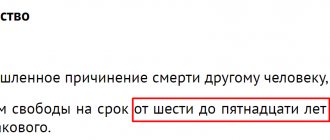Crime
A crime is an action that violates the law and is dangerous to society. Naturally, he will be punished. This is determined by Part 1 of Article 14 of the Criminal Code.
There are antisocial actions that are not dangerous to society. For example, petty theft. In such a situation, due to the absence of danger, there is no crime.
But it is important to distinguish such situations from cases where the action did not lead to serious consequences for reasons beyond the desire of the offender. In this case, his actions will be qualified as a criminal offense.
Some examples of criminal offenses related to acts of minor gravity
So that readers can get an idea of such crimes, in addition to the listed actions, such as theft or slander, it is worth giving examples of actions that provide for capital punishment in this category of crimes:
- Death by negligence, in case of exceeding self-defense measures or when a criminal is detained by an official (Article 108 of the Criminal Code of the Russian Federation).
- Murder by negligence (Article 109 of the Criminal Code of the Russian Federation).
- Causing severe or moderate harm to health in a state of passion (Article 113 of the Criminal Code of the Russian Federation).
- Battery or violent acts that have minor health consequences (Article 116 of the Criminal Code of the Russian Federation)
In each case, a criminal case is opened, but in the future, factors are considered that make it possible to reclassify a particular case as a crime of minor severity.
Definition
The severity of a crime is a set of categories for classifying illegal actions according to their danger to society.
Based on this classification, the punishment is determined. For serious crimes it is most severe.
According to the severity of the crime, they are characterized by four characteristics:
- Criminal wrongfulness - the prohibition of such acts by law;
- Danger to society – the ability to harm the interests and values of society, in particular, public relations;
- The presence of guilt is the proven presence of intent or accident;
- Criminal punishment is the presence of a penalty for this crime in a specific article of the Criminal Code.
If at least one of these characteristics is missing, then the action will not be recognized as an offense and does not imply punishment.
Average theft: how long can they give?
Such thefts are considered in Part 2 of Art. 158 of the Criminal Code of the Russian Federation. To bring a person to criminal liability, it is necessary to prove the presence of at least 1 of 4 qualifying criteria:
- participation of a group of people with an action plan;
- penetration into storage (these are all premises that do not belong to the home and are used for temporary storage of property);
- significant damage (more than 5 thousand rubles);
- theft from personal belongings that were with the victim.
The answer to the question about the appointment of punishment is contained in Art. 60 of the Criminal Code of the Russian Federation. Principles for determining sanctions:
- justice;
- proportionality to the crime;
- imposition of the prescribed punishment;
- assessment of mitigating and aggravating circumstances.
Thus, for theft of average gravity, the guilty person faces 5 years in prison. If the court takes into account the primacy of the crime, the positive characteristics of the attacker and other mitigating circumstances, this term will be reduced.
Theft is a type of theft and a generalized name for the offenses provided for in Part 1-4 of Art. 158 of the Criminal Code of the Russian Federation. They are done in different ways and therefore fall into different categories. To determine the degree of severity, it is necessary to correctly qualify the act. For any questions, you can contact our lawyers by phone or through the website. Specialists will correctly classify the crime, collect evidence and protect your rights in court.
Classification of crimes and its significance
Crimes according to severity are divided into:
- Slight heaviness. These include accidentally committed and intentional crimes, for which a punishment of no more than two years of imprisonment is provided;
- Moderate weight. This category includes crimes committed through negligence, for which a penalty of more than two years in prison is provided. Also included in this category are intentional crimes, which are punishable by at least five years;
- Grave - actions for which the punishment is no more than ten years;
- Particularly severe. For such crimes, punishment starts from 10 years in prison and up to life imprisonment.
The same crime in terms of the degree of public danger can differ significantly in the presence of certain circumstances. For example, for the rape of a minor, penalties will be more severe than when the victim is an adult. That is, two identical crimes, taking into account the different ages of the victims, will be classified as grave and especially grave.
There are other classifications based on the severity of crimes.
According to the form of guilt - intentional and negligent
By species and generic object. There are 13 chapters for a specific object, and five sections for a generic object: crimes in the economic sphere, against the individual, against public safety, state and military service.
In addition, there are special classifications of articles of the Criminal Code of the Russian Federation, highlighting corruption, violent and other crimes.
Categories of crimes depending on the nature and degree of public danger of the act
Article 15 of the Criminal Code of the Russian Federation provides for four categories of crimes:
- minor crimes;
- crimes of moderate gravity;
- serious crimes;
- especially serious crimes.
The classification is based on the nature and degree of social danger of the act.
The nature of public danger depends primarily on the significance of the object of encroachment and is its qualitative characteristic.
For understanding, let’s compare violent and non-violent attacks on property.
Non-violent types of assault are provided for, for example, by Articles 158, 159, 161 of the Criminal Code of the Russian Federation.
For example, theft, that is, the secret theft of someone else's property, is punishable by imprisonment for up to 2 years (Part 1 of Article 158 of the Criminal Code of the Russian Federation). A similar maximum penalty is provided for in Part 1 of Article 159 of the Criminal Code of the Russian Federation for committing fraud, that is, theft of someone else’s property or acquiring the right to someone else’s property through deception or abuse of trust.
Committing robbery, that is, open theft of someone else's property, is already punishable by imprisonment for a term of up to four years.
Violent types of assault are provided for, for example, in Articles 161 and 162 of the Criminal Code of the Russian Federation.
So, for example, robbery (open theft of property) committed with the use of violence that is not dangerous to life or health, or with the threat of using such violence, is punishable by imprisonment for 7 years (Part 2 of Article 161 of the Criminal Code of the Russian Federation).
Another example: robbery, that is, an attack for the purpose of stealing someone else’s property, committed with the use of violence dangerous to life or health, or with the threat of such violence, is punishable by imprisonment for up to 8 years (Part 1 of Article 162 of the Criminal Code of the Russian Federation).
It is obvious that non-violent attacks on property are less significant in terms of the nature of social danger than violent ones, since in the first case the criminal encroaches only on one group of social relations - property, while in the second case, the criminal encroaches on two groups of social relations (the health of the victim and his own). The sanctions for encroaching on two groups of relations at once are more severe, which seems logical.
The degree of public danger is considered a quantitative characteristic of the attack. It is influenced by the nature and magnitude of the damage (consequences), the form of guilt, the methods of committing the act, the stage of the crime, etc.
The degree of public danger of a crime is determined by the circumstances of the crime (for example, the degree of implementation of the criminal intent, the method of committing the crime, the amount of harm or the severity of the consequences, the role of the defendant in the commission of the crime as an accomplice).
Grave and especially grave crimes: definition, types and classification
Serious crimes attack the most important social values:
Have a question for a lawyer? Ask now, call and get a free consultation from leading lawyers in your city. We will answer your questions quickly and try to help with your specific case.
Telephone in Moscow and the Moscow region: +7
Phone in St. Petersburg and Leningrad region: +7
Free hotline throughout Russia: 8 (800) 301-39-20
- Health;
- Life;
- Safety.
Such crimes always require intent. They are not committed through negligence.
Serious crimes are punishable by ten years in prison, and especially serious ones - up to life imprisonment.
Moreover, the separation of these two categories often occurs on the basis of the object of criminal attacks or the circumstances of the crime. Thus, in Article 111 of the Criminal Code, intentional infliction of grievous bodily harm is classified as a grave crime. Even if a weapon or other generally dangerous method is used, this action will be a serious crime. But in the case of a group of people acting in conspiracy or several victims, this crime will be classified as especially serious.
What acts qualify as “minor crimes”?
Russian legislation defines crimes that provide for the lightest punishments. Usually we are talking about intentional and careless actions, which provide for punishment in the form of correctional labor or a serious fine. In exceptional situations, the court imposes up to three years in prison. Minor crimes include:
| Type of criminal act | Measure of responsibility |
| Minor damage to health (Article 115 of the Criminal Code of the Russian Federation). | Provides for a fine corresponding to three salaries of the guilty person, or 400 hours of disciplinary work. In some cases, the offender may be placed under arrest for a period of four months. |
| The use of weapons during lawlessness for political or national reasons, from hooligan motives. | Such violations are punishable by isolation from society for a period of six months or correctional labor for two years. |
It is important to note here that since the citizen committed illegal actions classified as criminal, there are no valid reasons for refusing to initiate a criminal case.
It is important to be able to distinguish such lawlessness from administrative offenses, which are sometimes very similar, but the punishment provided for is completely different, and a criminal case is not opened. For example, theft will not be considered a crime of average gravity if the perpetrator had no idea of the consequences and was mistaken about his actions. In addition, such offenses cause minimal harm to society, which can be easily compensated, and therefore deserve more lenient punishment than other criminals who have committed serious atrocities.
Examples of grave and especially grave crimes
The most common examples are crimes involving violence - against sexual integrity and threatening human life, that is, rape and murder. This also includes robbery, aggravated kidnapping and a number of other crimes.
Serious crimes include rape (Article 131), coercion to testify using violence (Article 309), theft of especially valuable items (Article 164), etc.
Particularly serious: murder (Article 105), terrorist attack (Article 205), infection with especially dangerous diseases (Article 131), kidnapping (Article 126), robbery (Article 162), etc.
It is important to understand that the question of how to determine the severity of a crime is not always resolved when assessing the fact of the crime itself. It is extremely important to correctly qualify the circumstances of the attacker’s actions. The same crime, in the presence of aggravating circumstances, may fall into a different category of severity, and, accordingly, be punished more severely.
Thus, an abduction committed by an organized group with a preliminary conspiracy will be classified as more serious than simply the abduction of one person by another.
Categories of crimes
The division into categories is inherent in the specifics of criminal law. This is due to the unfavorable consequences that come with committing a crime, namely the expungement of a criminal record. The punishment for theft determines the severity of the act, and one or another category affects the moment when the guilty person becomes unconvicted.
Art. 15 of the Criminal Code of the Russian Federation provides for 4 degrees of severity:
- small is characterized by insignificant damage;
- the average includes the most dangerous careless acts, as well as the first qualified group provided for by the norm;
- serious crimes;
- especially serious acts.
The last two categories refer to the most socially dangerous violations, which are committed under aggravating circumstances and exclusively in an intentional form.
Types of crimes
There are many classifications of crimes according to their composition. The presence of intent or the random nature of the crime, the object of the attack, as well as the degree of danger are taken into account.
According to the degree of danger they are distinguished:
- A simple crime. In this case, there are no additional signs of a crime;
- Qualified presupposes the presence of aggravating circumstances. This could be an organized group, relapse, use of violence and weapons, etc.;
- Privileged. Such a crime arises when there are grounds for mitigating the punishment in comparison with the main crime.









